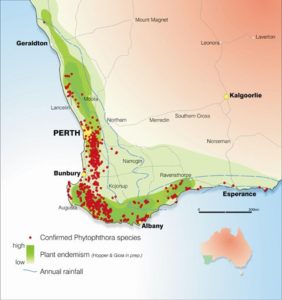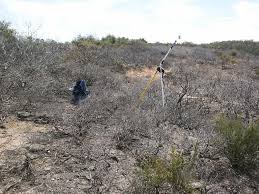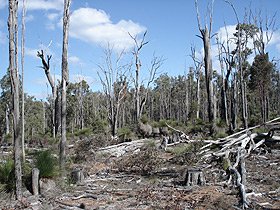Phytophthora cinnanomi killing Ione manzanita in California; photo from Swiecki and Garbelotto, Distribution of Phytophthora cinnamomi within the range of Ione manzanita (Arctostaphylos myrtifolia). Agreement between the California Department of Fish and Game and University of California
Phytophthora species are plant pathogens in the oomycote group (water molds, closely related to brown algae). More than 160 species have been described; new species are continually being isolated. Many Phytophthora species are deadly to naïve hosts; examples in the United States include sudden oak death, Port-Orford cedar root disease, disease on chestnuts and oaks.
Forests in Europe – especially the United Kingdom – and Australia are also suffering high levels of mortality associated with one or more Phytophthora species.
In recent years, several studies have documented the role of nurseries in spreading non-native Phytophthora species. Two strains of P. ramorum are widespread in European nurseries and in tree plantations and wild heathlands of southwest England, Wales, parts of Scotland, and Ireland. (See here and here.)
In April 2016 I blogged about the situation in Europe described by Jung et al. 2015 (see references at the end of the blog). Jung et al. concluded that diseases caused by Phytophthora pose a substantial threat to both planted landscapes and forest ecosystems across Europe. They found 56 Phytophthora taxa in 66% of 2,525 forest and landscape planting sites that were probably introduced to those sites via nursery plantings.
Barber et al. 2013 reported nine species of Phytophthora associated with a wide variety of host species in urban streetscapes, parks, gardens, and remnant native vegetation in urban settings in Western Australia. Phytophthora spp were recovered from 30% of sampled sites.
A new summary confirms that the threat is similar in North America. In British Columbia, Dale et al. (2017) found more than two times as many Phytophthora species were detected in soil and water samples in urban areas (23) than in natural areas (11). Urban samples also showed a much higher diversity of Phytophthora per site than natural environments. These Phytophthora species had been introduced initially into urban areas and had subsequently spread into native vegetation, particularly in areas near developed sites (wildland-urban interface areas).
Swiecki et al 2018 cite several sources and their own studies to show that the large and increasingly diverse contingent of introduced Phytophthora species pose an increasingly important threat to both urban forests and surrounding native forests and plant communities in California. It is clear that shrubs and herbaceous plants as well as trees are also at risk. These scientists have repeatedly found multiple non-native Phytophthora species at individual sites in northern and southern California sites where nursery stock had been planted. Sampling in 2014 identified about 60 different Phytophthora taxa in restoration planting sites and native plant nurseries. The sampled restoration plantings were mostly located in urban riparian corridors and peri-urban parks, open spaces, or protected watersheds.
I first discussed this issue in a blog in July 2016.
Swiecki et al (2018) have also found that Phytophthora species persist in drier ecosystems. When conditions are too dry for sporangium production, Phytophthora hyphae produce resistant survival structures that can tolerate drying and persist in dead root fragments or soil. In the presence of appropriate stimuli, e.g., moisture and root exudates, resistant structures germinate to produce sporangia or hyphae, leading to new infections. Even relatively short wet periods associated with rain or irrigation can be sufficient to stimulate zoospore release. Swiecki et al (2018) list examples of numerous Phytophthora infestations that developed in dry sites, such as dry foothills of the Sierra Nevada in Amador County, and the Oakland Hills of Alameda & Contra Costa County. Swiecki et al. (2018) also note that P. cinnamomi has persisted in Australian forests in the absence of known primary hosts.
Phytophthora infections can also persist for decades in soil. In California, Swiecki et al. (2018) mention several examples:
- Residual cinnamomi inoculum killed young sprouts of susceptible manzanitas (Arctostaphylos myrtifolia and A. viscida) planted on sites that were infected many years earlier.
- A street planting of cork oaks (Quercus suber) apparently died due to Phytophthora root rot that had occurred 21 years earlier.
- Both cinnamomi and P. cactorum were recovered from roots and soil beneath affected trees at least 60 years after the site had been a municipal woody plant nursery and adjacent residence.
- A 7-acre area of native vegetation showing decline & mortality of multiple plant species was infested with multiple Phytophthora spp, including cactorum, P. cambivora, P. crassamura, P. ‘kelmania’ & P. syringae. The site was apparently infected 22 years earlier during a planting of a habitat restoration project using Ceanothus nursery stock. Subsequent spread was primarily downhill from the planting sites, facilitated by water flow, with additional spread along and near trails.
The Risk from the Nursery Trade
While Phytophthora-infested soil and plant debris can be transported on tools, vehicles, and shoes, or moved in large quantities when infested soil is excavated, graded, or imported, the principal threat is the nursery trade.
- Jung et al. (2015) state that widespread contamination of nursery stock was the primary means by which these pathogens were introduced and spread in Europe. They found 49 Phytophthora taxa in 670 European nurseries. Phytophthora species were recovered from more than 90% of the sampled nurseries.
- Swiecki et al. (2018) say that most of the common Phytophthora species detected in California are distributed globally, moved about with live plants or other infested materials. None is native to California.
- Swiecki et al. (2018) cite studies reporting that thirteen species of Phytophthora were found in a survey for leaf spots in California nurseries in 2005 and 2006. Sampling of plants in or originating from Calif native plant nurseries alone has yielded about 60 Phytophthora At least eight species of Phytophthora were found in shipments of symptomatic and asymptomatic plants sent from west coast nurseries to Maryland. Parke et al. (2014) identified 28 Phytophthora taxa in four Oregon nurseries.
- Not all infections are on the West Coast. Swiecki et al. (2081) reports that a survey in Minnesota nurseries of plants with symptoms – primarily on aboveground plant parts – found eleven species of Phytophthora.
Are scientists in other parts of the country looking for Phytophthora? I see no reason to think the situation in California is unique.
The damage caused by Phytophthora infections can be significant. In California and Oregon, sudden oak death, and Port-Orford cedar root disease, have killed well over a million trees and disrupted the ecosystems of which they are a part. There are multiple locations in Northern California where introduced Phytophthora species, especially P. cinnamomi and P. cambivora, have caused localized to extensive decline and mortality in native forests and shrublands.
Phytophthora dieback has infected more than one million hectares in Western Australia. More than 40% of the native plant species of the region are vulnerable to the causal agent, P. cinnamomi.
 Phytophthora dieback in Western Australia
Phytophthora dieback in Western Australia
Dieback in native forest in Western Australia; photo copyright Western Australian Department of Parks and Wildlife
In the United Kingdom, several Phytophthora species are causing widespread mortality of native shrubs and trees and commercial plantings.
In nearly all the studies, scientists have detected previously unknown pathogen-host relationships.
The threat from spreading pathogens with wide host ranges is not limited to the genus Phytophthora. The fungus Fusarium euwallacea associated with the Kuroshio and polyphagous shot hole borers is known to kill at least 18 species of native plants in California and additional species in South Africa. The laurel wilt fungus kills many trees and shrubs in the Lauraceae family. ‘Ohi‘a or myrtle rust kills several shrubs native to Hawai`i and threatens a wide range of plants in the Myrtaceae family in Australia and New Zealand. Some insects also have wide host ranges, including the Kuroshio and polyphagous shot hole borers; and Asian longhorned and citrus longhorned beetles.
When are national and international phytosanitary agencies going to adopt policies and programs that are effective in preventing the continued spread of these highly damaging tree-killing pests? At the national level, APHIS needs to aggressively use two authorities to curtail importation of plant taxa from countries of origin which present a risk of transporting additional species of pathogens:
- NAPPRA, which allows APHIS to prohibit risky imports until it has conducted a pest risk analysis.
- Programs under the revised “Q-37” regulations allowing APHIS to work with exporting countries’ phytosanitary officials to implement integrated pest management strategies to ensure that plants are pathogen-free before they are exported.
I have blogged about both programs before – NAPPRA here; the Q-37 regulation strengthening here.
At the international level, the members of the International Plant Protection Convention (IPPC) must recognize the failure of the international phytosanitary system and explore ways to strengthen it. See my numerous blogs on this topic (beyond those linked to here!) by visiting www.cisp.us or www.nivemnic.us and searching under the category “forest pathogens”.
Posted by Faith Campbell
We welcome comments that supplement or correct factual information, suggest new approaches, or promote thoughtful consideration. We post comments that disagree with us — but not those we judge to be not civil or inflammatory.
SOURCES
Jung, T. et al. 2015 “Widespread Phytophthora infestations in European nurseries put forest, semi-natural and horticultural ecosystems at high risk of Phytophthora disease” Forest Pathology. November 2015; available from Resource Gate
Swiecki, T.J., E.A. Bernhardt, and S.J. Frankel. 2018. Phytophthora root disease and the need for clean nursery stock in urban forests: Part 1 Phytophthora invasions in the urban forest & beyond. Western Arborist Fall 2018
Apparently can’t access current (2018) issues of “Western Arborist” on web unless subscribe

